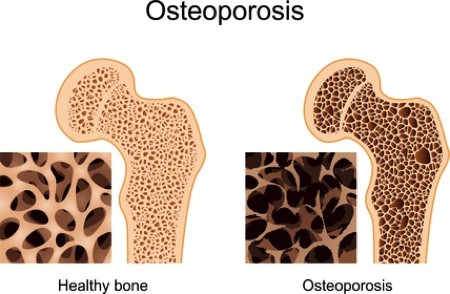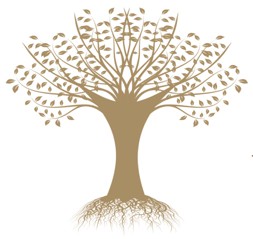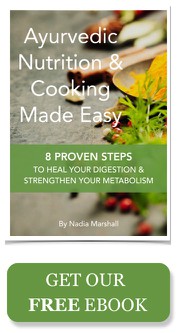By Kester Marshall
Osteoporosis is a progressive bone disease that is characterised by a decrease in bone mass and density. It is most common in women after menopause when it is referred to as primary type 1 or postmenopausal osteoporosis. Primary type 2 osteoporosis is referred to as senile osteoporosis and occurs in men and women, usually after the age of 75, while secondary osteoporosis occurs due to chronic pre-existing medical conditions or use of medications such as glucocoticoids (steroids).
When women go through menopause the 'bone turnover rate' is affected by hormonal changes and the osteoblasts (cells responsible for laying down new bone) have trouble keeping up with the osteoclasts (cells responsible for the removal of old bone). As a result the bone develops 'pot-holes' over time and decreases in density.
The conventional medical approach to osteoporosis usually involves calcium supplementation, hormone replacement therapy (HRT) and the use of drugs (such as bisphosphonates) that reduce the activity of osteoclasts, and in the short term at least increasing bone density. The side effects of HRT are becoming more well known these days, but little is heard about drugs like bisphosphonates. They can cause heartburn, headaches, constipation, diarrhoea, muscle and joint pain, cramps, stomach pain, dizziness and tiredness, ulcers and possible femoral fractures. One speculation is that although these drugs slow bone resorption and increase bone density short term, they are slowing overall bone turnover rate. This means that old or damaged bone is not removed as quickly and in the longer term this may lead to further weakening.
From an Ayurvedic point of view, menopause marks a natural transition from a pitta predominant phase of a woman's life to a vata predominant phase. Vata has no physical form (it is comprised of the elements of air and ether) and therefore when it is in excess, has a catabolic effect on the body tissues. Vata also has a very close relationship with the bone tissue and so naturally this catabolic effect will be seen here most readily.
In Ayurveda this depletion of the bone tissue is called 'Asthikshaya' and occurs due to two main mechanisms. The first is deficiency of nutrients suitable for nourishing the bone because of malnutrition and/or the catabolic activity of Vata dosha. The second is blockage of the channels/pathways responsible for conveying this nutrition to the bone tissue (known as srotarodha), usually as a result of imbalanced digestion (Agni) and the formation of Ama. It can also occur due to a combination of both.
Both of these causes need to be addressed. If there is Ama present in the channels causing blockages and interfering with metabolism then no amount of calcium supplementation or bone nourishing measures will do much good. The Ama must be removed first and the metabolism of the bone tissue enhanced in order for the nourishing supplements to do their job.
This is best done through simple fasting (preferably under the guidance of a practitioner) and light diet appropriate for the individual, to reduce the buildup of Ama and ensure the digestive fire is functioning well. This will enhance digestion, absorption and assimilation of all the nutrients necessary for the formation of healthy bone.
It is best to avoid excess red meat and animal protein. An excess of this kind of protein can create an acidic environment in the body and calcium (being an alkaline mineral) is taken from the bones in order to balance the pH of the blood thereby weakening them over time. This also applies to other acid-forming foods such as alcohol, refined sugar and refined flour.
Low fat foods are also contradicted as vitamin D (which is essential for bone metabolism) is a fat soluble vitamin and cannot be absorbed without it.
Calcium-containing foods include whole, unprocessed milk (in Ayurveda this should be heated and spiced to enhance digestibility), cooked green leafy vegetables such as kale or spinach, sesame seeds or tahini, sardines, and in terms of grains amaranth is also good. According to Ayurveda, foods that specifically nourish bone tissue include: spelt, black grapes, radish, beetroot, sugar cane, garlic and ginger. It is also important to prepare phytate-containing foods such as grains, legumes, nuts and seeds in a way that reduces their phytate content and therefore increases the bioavailability of calcium. These methods include soaking and pressure-cooking legumes and pulses and soaking or toasting nuts and seeds (1&2).
An adequate amount of gentle weight bearing exercise is necessary to encourage the proper formation of bone, especially for those who have a more sedentary lifestyle, and a daily dose of sunshine is also essential for the synthesis of vitamin D.
Excess 'colonics' or colon hydrotherapy is recommended against in Ayurveda as there is a direct relationship between the membrane of the colon (purishadharakala) and the membrane surrounding the bone tissue that provides it with nourishment (asthidharakala). The colon is the 'seat' of vata in the body and any irritation or excessive dryness in this organ will cause aggravation of vata dosha and further depletion of the bone.
Regular self massage (abhyanga) with warm cold pressed sesame oil is excellent for reducing excess vata and therefore reducing its catabolic activity on the bones.
All of the measures mentioned so far should be adequate prevention for the majority of people, but if osteoporosis or osteopaenia are already present there are valuable herbal preparations available that can help removal of Ama, bring balance to the hormones, improve metabolism of the bones and specially prepared mineral supplements to provide bioavailable calcium and enhance bone nourishment.
There is also a special type of Pindaswed massage, done with warm rice boluses that have been prepared in milk and herbs and then dipped in medicated oil. This has the dual effect of removing blockages of Ama from the channels as well as strengthening and toning the muscle, nerve and bone tissue.
In extreme conditions of depletion medicated oil in the form of enemas can also be useful, especially when used as part of a deeper treatment program of cleansing and rejuvenation known as Panchakarma. Given the close connection between the colon, the bones and vata dosha, medicated enemas are considered one of the best methods of treating vata-related conditions.
If you’d rather avoid enemas, don’t worry.. there are a vast array of approaches in Ayurveda to help bone density issues for both women and men, of any age!
If you are in any doubt about your health please be sure to consult an Ayurvedic Practitioner or your local health physician.




